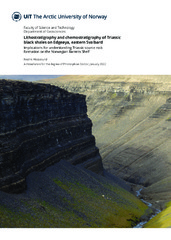| dc.contributor.advisor | Grundvåg, Sten-Andreas | |
| dc.contributor.author | Wesenlund, Fredrik | |
| dc.date.accessioned | 2022-03-10T09:48:29Z | |
| dc.date.available | 2022-03-10T09:48:29Z | |
| dc.date.issued | 2022-03-25 | |
| dc.description.abstract | The Norwegian Barents Shelf (NBS) is an Arctic petroleum province with a complex geological history. Current geochemical work on oil discoveries in the region has identified Triassic mudstones as important petroleum source rocks. A review of the published literature found that several source rock-forming processes have been suggested as contributors to their formation. The aim of this thesis is thus to further understand the paleoenvironmental factors that affected Triassic source rock formation and potential on the NBS. This was done by investigating the lithostratigraphy and organic/inorganic chemostratigraphy of the organic-rich Spathian–Carnian outcrops on Edgeøya, eastern Svalbard. These exposures represent uplifted and exhumed strata of the northwestern NBS that are equivalent to Triassic source rocks on the southern NBS. Paper I characterizes the mudstone facies and bulk organic properties of the Anisian–Ladinian Botneheia Formation to investigate benthic redox conditions, productivity, and organic richness. Paper II performs a multi-elemental chemostratigraphic analysis to further clarify how these environmental factors affected Spathian–Carnian source rock formation. Paper III documents source- and maturity-specific biomarker compounds of the investigated succession and their correlation with oils from the Alta, Gohta, Wisting Central and Hanssen discoveries on the NBS. These papers consider the reported climate-induced transition from warmer to cooler oceans at the Spathian–Anisian boundary to have an important impact on Spathian vs. Anisian–Ladinian source rock formation in the region. The early Carnian pro-deltaic mudstones terminated formation of oil-prone source rocks due to the prograding Triassic Boreal Ocean delta system in the south. Spathian mudstone extracts from Svalbard and the Spathian-sourced Wisting Central/Hanssen oils show strong biomarker correlations, indicating that these age-equivalent source rocks have comparable organic facies. This challenges the idea that Spathian mudstones on the southern NBS are lateral facies equivalents to the Anisian–Ladinian mudstones in Svalbard. These findings have important implications for conceptualizing the Lower–Upper Triassic source rock models on the NBS. | en_US |
| dc.description.doctoraltype | ph.d. | en_US |
| dc.description.popularabstract | Fossil fuels account for more than 80 % of the World’s energy consumption. Knowledge of how petroleum forms is therefore still relevant. Ancient organic matter from plankton within mudstones is an important source for petroleum. Approximately 240–250 million years ago, plankton-rich muds were deposited in a shallow ocean north of Norway and can now be studied as organic-rich mudstones in Svalbard. This study aims to investigate the ancient environmental conditions that allowed this organic matter to be created, preserved, and accumulated within these mudstones. Through field work in Svalbard and geochemical analyses, we found out that climate changes approximately 247 million years ago could have influenced the nutrient and oxygen content in the water column, both very important factors for such petroleum-generating mudstones to form. This will help us understand in more detail how these mudstones can be distributed on the Barents Shelf and their ability to generate petroleum. | en_US |
| dc.description.sponsorship | The PhD project is funded by the Research Centre for Arctic Petroleum Exploration (ARCEx), a research collaboration between academia and industry. ARCEx is funded by the Research Council of Norway (RCN grant no. 228107), 6 industry partners (Equinor, Vår energi, Aker BP, Lundin, Wintershall Dea, and OMV), Troms fylkeskommune, and by in-kind contributions. Additional funding was also recieved by Kong Haakon den VIIdes utdannelsesfond for norsk ungdom and Nasjonal forskerskole i petroleumsfag (NFiP). | en_US |
| dc.identifier.isbn | 978-82-8236-470-6 | |
| dc.identifier.uri | https://hdl.handle.net/10037/24363 | |
| dc.language.iso | eng | en_US |
| dc.publisher | UiT Norges arktiske universitet | en_US |
| dc.publisher | UiT The Arctic University of Norway | en_US |
| dc.relation.haspart | <p>Paper I: Wesenlund, F., Grundvåg, S.-A., Engelschiøn, V.S., Thießen, O. & Pedersen, J.H. (2021). Linking facies variations, organic carbon richness and bulk bitumen content – A case study of the organic-rich Middle Triassic shales from eastern Svalbard. <i>Marine and Petroleum Geology, 132</i>, 105168. Also available in Munin at <a href=https://hdl.handle.net/10037/22623>https://hdl.handle.net/10037/22623</a>.
<p>Paper II: Wesenlund, F., Grundvåg, S.-A., Engelschiøn, V.S., Thießen, O. & Pedersen, J.H. Multi-elemental chemostratigraphy of Triassic mudstones in eastern Svalbard: implications for source rock formation in front of the World’s largest delta plain. (Accepted manuscript). To be published in <i>The Depositional Record</i>, 2022, available at <a href= https://doi.org/10.1002/dep2.182> https://doi.org/10.1002/dep2.182</a>.
<p>Paper III: Wesenlund, F., Grundvåg, S.-A., Thießen, O., Engelschiøn, V.S., Lerch, B., & Pedersen, J. H. Organic chemostratigraphy of Triassic black shales in Svalbard: implications for Triassic source facies development, thermal maturity evaluations, and correlations with Barents Sea oils. (Manuscript). | en_US |
| dc.rights.accessRights | openAccess | en_US |
| dc.rights.holder | Copyright 2022 The Author(s) | |
| dc.rights.uri | https://creativecommons.org/licenses/by-nc-sa/4.0 | en_US |
| dc.rights | Attribution-NonCommercial-ShareAlike 4.0 International (CC BY-NC-SA 4.0) | en_US |
| dc.subject | VDP::Matematikk og Naturvitenskap: 400::Geofag: 450::Petroleumsgeologi og -geofysikk: 464 | en_US |
| dc.subject | VDP::Mathematics and natural science: 400::Geosciences: 450::Petroleum geology and petroleum geophysics: 464 | en_US |
| dc.subject | VDP::Matematikk og Naturvitenskap: 400::Geofag: 450::Stratigrafi og paleontologi: 461 | en_US |
| dc.subject | VDP::Mathematics and natural science: 400::Geosciences: 450::Stratigraphy and paleontology: 461 | en_US |
| dc.subject | VDP::Matematikk og Naturvitenskap: 400::Geofag: 450::Sedimentologi: 456 | en_US |
| dc.subject | VDP::Mathematics and natural science: 400::Geosciences: 450::Sedimentology: 456 | en_US |
| dc.subject | VDP::Matematikk og Naturvitenskap: 400::Geofag: 450::Mineralogi, petrologi, geokjemi: 462 | en_US |
| dc.subject | VDP::Mathematics and natural science: 400::Geosciences: 450::Mineralogy, petrology, geochemistry: 462 | en_US |
| dc.title | Lithostratigraphy and chemostratigraphy of Triassic black shales on Edgeøya, eastern Svalbard: Implications for understanding Triassic source rock formation on the Norwegian Barents Shelf | en_US |
| dc.type | Doctoral thesis | en_US |
| dc.type | Doktorgradsavhandling | en_US |


 English
English norsk
norsk

